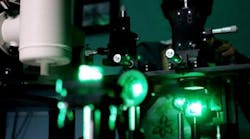Clear as ... Paper? Scientists 'See' through Solid Layers
Scientists said they have developed a method to "see through" layers of thin, solid material in a breakthrough that holds promise for medical imaging, nanotechnology -- and the spy trade.
A team of scientists from the Netherlands and Italy have developed a new technique using lasers and computer decoding to "see" an object behind a non-see-through barrier made of ground glass.
Using the same technology, they would also be able to look behind a sheet of paper or a thin layer of paint, said study co-author Allard Mosk of the Institute for Nanotechnology at the University of Twente in the Netherlands.
With improvements, "20 years in the future I think we might have a device the size of an iPhone that you could hold on the scattering material [the non-see-through layer] and you push a button or maybe speak a command ... and you'd be seeing what's behind it," the physicist told AFP.
Some objects, like paper, skin or frosted glass, let through limited light, but diffuse it so much that the human eye cannot see beyond them -- like trying to see through fog.
The new method works by shining a laser on the barrier, in this case a translucent screen of ground glass made by an optics company. The disk does not allow any light to pass through in a straight line but scatters it all.
The diffused light that makes it through the glass then hits an object behind the screen, which returns some of that light onto the backside of the screen, the team wrote in the journal Nature.
This light, by now completely scrambled and so low that it can no longer be seen by the naked eye, is then analysed by a computer decoding programme that reproduces an image of the hidden object, Mosk said.
"We don't see the object itself, we don't see its shape, but thanks to our scanning method all we really need to know is the amount of light," he explained.
Decoding the light pattern "is like a huge puzzle and fortunately it's a puzzle of the type that computers are very good at."
Potential Applications
Mosk said the technology could be useful for non-invasive scanning in medicine and in the field of nanotechnology -- seeing inside a computer chip without having to open it.
"In principle, you could read a letter though an envelope, which might be good if you are a spy."
Existing technologies allow scientists to see through materials that partly, not entirely, scatter light. And unlike the new technique, today's methods work by using the non-scattered portion of light.
But don't expect X-ray specs anytime soon, as the new laser technique could never work on black, entirely light-absorbing surfaces, said Mosk, quipping that "a wall would be quite a challenge".
Nor would it be useful to the pursuits of Peeping Toms.
"Our method is pretty good at looking through things, but before all kinds of peepers try and call us: it is not good for looking through something sneakily -- you would notice if someone points a very bright laser at you," the scientist said.
-- Mariette Le Roux, AFP
Copyright Agence France-Presse, 2012




